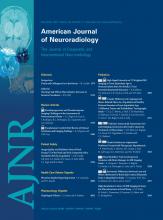Research ArticleInterventional
Testing Flow Diverters in Giant Fusiform Aneurysms: A New Experimental Model Can Show Leaks Responsible for Failures
T.E. Darsaut, F. Bing, I. Salazkin, G. Gevry and J. Raymond
American Journal of Neuroradiology December 2011, 32 (11) 2175-2179; DOI: https://doi.org/10.3174/ajnr.A2657
T.E. Darsaut
aFrom Centre hospitalier de l'Université de Montréal (CHUM), Notre-Dame Hospital, Department of Radiology (T.E.D., F.B., J.R.)
bCHUM Research Centre, Interventional Neuroradiology Research Laboratory (T.E.D., I.S., G.G., J.R.), Montreal, Quebec, Canada
cUniversity of Alberta, Mackenzie Health Science Centre, Division of Neurosurgery (T.E.D.), Edmonton, Alberta, Canada.
F. Bing
aFrom Centre hospitalier de l'Université de Montréal (CHUM), Notre-Dame Hospital, Department of Radiology (T.E.D., F.B., J.R.)
I. Salazkin
bCHUM Research Centre, Interventional Neuroradiology Research Laboratory (T.E.D., I.S., G.G., J.R.), Montreal, Quebec, Canada
G. Gevry
bCHUM Research Centre, Interventional Neuroradiology Research Laboratory (T.E.D., I.S., G.G., J.R.), Montreal, Quebec, Canada
J. Raymond
aFrom Centre hospitalier de l'Université de Montréal (CHUM), Notre-Dame Hospital, Department of Radiology (T.E.D., F.B., J.R.)
bCHUM Research Centre, Interventional Neuroradiology Research Laboratory (T.E.D., I.S., G.G., J.R.), Montreal, Quebec, Canada

References
- 1.↵
- Fiorella D,
- Woo HH,
- Albuquerque FC,
- et al
- 2.↵
- Fiorella D,
- Kelly ME,
- Albuquerque FC,
- et al
- 3.↵
- Lylyk P,
- Miranda C,
- Ceratto R,
- et al
- 4.↵
- Szikora I,
- Berentei Z,
- Kulcsar Z,
- et al
- 5.↵
- Kulcsár Z,
- Houdart E,
- Bonafé A,
- et al
- 6.↵
- Turowski B,
- Macht S,
- Kulcsár Z,
- et al
- 7.↵
- Byrne JV,
- Beltechi R,
- Yarnold JA,
- et al
- 8.
- Kallmes DF,
- Ding YH,
- Dai D,
- et al
- 9.
- Kallmes DF,
- Ding YH,
- Dai D,
- et al
- 10.↵
- Lieber BB,
- Sadasivan C.
- 11.↵
- Bouzeghrane F,
- Naggara O,
- Kallmes DF,
- et al
- 12.↵
- Raymond J,
- Salazkin I,
- Metcalfe A,
- et al
- 13.↵
- 14.↵
- Kamran M,
- Yarnold J,
- Grunwald IQ,
- et al
- 15.↵
- Raymond J,
- Salazkin I,
- Gevry G,
- et al
- 16.↵
- Lubicz B,
- Collignon L,
- Raphaeli G,
- et al
- 17.↵
- Appanaboyina S,
- Mut F,
- Lohner R,
- et al
In this issue
Advertisement
T.E. Darsaut, F. Bing, I. Salazkin, G. Gevry, J. Raymond
Testing Flow Diverters in Giant Fusiform Aneurysms: A New Experimental Model Can Show Leaks Responsible for Failures
American Journal of Neuroradiology Dec 2011, 32 (11) 2175-2179; DOI: 10.3174/ajnr.A2657
0 Responses
Jump to section
Related Articles
- No related articles found.
Cited By...
- Surgical technique for venous patch aneurysms with no neck in a rabbit model
- Flow diversion of bifurcation aneurysms is more effective when the jailed branch is occluded: an experimental study in a novel canine model
- Testing Stenting and Flow Diversion Using a Surgical Elastase-Induced Complex Fusiform Aneurysm Model
- Compaction of flow diverters improves occlusion of experimental wide-necked aneurysms
- The Success of Flow Diversion in Large and Giant Sidewall Aneurysms May Depend on the Size of the Defect in the Parent Artery
- Variable Porosity of the Pipeline Embolization Device in Straight and Curved Vessels: A Guide for Optimal Deployment Strategy
- Flow diversion to treat aneurysms: the free segment of stent
- The Varying Porosity of Braided Self-Expanding Stents and Flow Diverters: An Experimental Study
- Thrombosis Heralding Aneurysmal Rupture: An Exploration of Potential Mechanisms in a Novel Giant Swine Aneurysm Model
- Flow Diverters Can Occlude Aneurysms and Preserve Arterial Branches: A New Experimental Model
This article has been cited by the following articles in journals that are participating in Crossref Cited-by Linking.
- M. Shapiro, E. Raz, T. Becske, P. K. NelsonAmerican Journal of Neuroradiology 2014 35 4
- A. Makoyeva, F. Bing, T.E. Darsaut, I. Salazkin, J. RaymondAmerican Journal of Neuroradiology 2013 34 3
- Osman Melih Topcuoglu, Erol Akgul, Ergun Daglioglu, Elif Dilara Topcuoglu, Ahmet Peker, Ilkay Akmangit, Deniz Belen, Anil AratWorld Neurosurgery 2016 87
- T.E. Darsaut, F. Bing, I. Salazkin, G. Gevry, J. RaymondAmerican Journal of Neuroradiology 2012 33 10
- J. Raymond, T.E. Darsaut, M. Kotowski, A. Makoyeva, G. Gevry, F. Berthelet, I. SalazkinAmerican Journal of Neuroradiology 2013 34 2
- R Fahed, J C Gentric, I Salazkin, G Gevry, J Raymond, T E DarsautJournal of NeuroInterventional Surgery 2017 9 3
- Serge Marbacher, Fabio Strange, Juhana Frösén, Javier FandinoJournal of Cerebral Blood Flow & Metabolism 2020 40 5
- Leonid Goubergrits, Jens Schaller, Ulrich Kertzscher, Thies Woelken, Moritz Ringelstein, Andreas SpulerExpert Review of Medical Devices 2014 11 4
- Jean-Christophe Gentric, Igor Salazkin, Guylaine Gevry, Jean Raymond, Tim DarsautJournal of NeuroInterventional Surgery 2016 8 10
- Tim E Darsaut, Fabrice Bing, Alina Makoyeva, Guylaine Gevry, Igor Salazkin, Jean RaymondJournal of NeuroInterventional Surgery 2013 5 5
More in this TOC Section
Similar Articles
Advertisement











